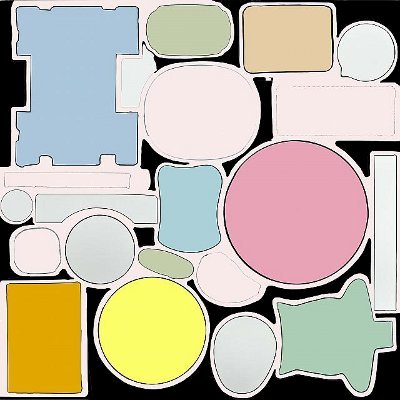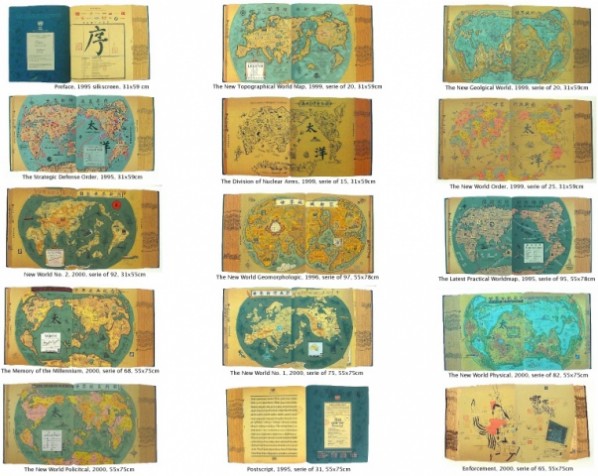
After Lunar New Year in China, Pace Beijing will present the solo exhibition of Hong Hao, the renowned contemporary Chinese artist who is newly represented by PACE. The exhibition will be a comprehensively retrospective of the artist’s works from various periods of his career as well as exhibiting new works. This exhibition will also be the first public show of his 2013 series Deja vu since Hong Hao’s solo exhibition As It Is in 2011. Hong Hao questions and critic izes the survival in reality in his unique satire and parody style, and he also discusses aesthetics by using a highly representative language, which is based on his talent of using various media and his creational methods with oriental origins. The exhibition will last from 16th March to 27th April.
 Hong Hao, "Deja vu V", 2012, pen, pencil, acrylic, digital print on canvas, 136x136cm 2013
Hong Hao, "Deja vu V", 2012, pen, pencil, acrylic, digital print on canvas, 136x136cm 2013
Hong Hao, "Deja vu V", 2012, pen, pencil, acrylic, digital print on canvas, 136x136cm 2013
The new series Deja vu extends from Hong Hao’s previous concept of making art by scanning, which preserves the original shape of the material. After procedures such as collecting, limning, scanning and painting after print, Hong Hao’s artwork breaks the traditional rules of production and techniques, and also passes the boundary of media. Besides, after removing from the functional and commercial impact which comes from public opinions in a logic way, his artwork returns to the thinking of pure aesthetics, and blur the physical form of certain objects but focus on the archetype. Hong Hao’s work shows both the spatial relationship between different objects after dematerialization and the artist’s will, which returns to the very early stage that is pure and simple after experiencing the reality, but obtaining more wisdom than the very beginning that is refined from the experience. In addition, videos will also be included in the exhibition. One of the videos, Taichi, is the recording of the process that the artist practices Taichi every day. From different perspective, it get the awareness of the relationship between the human being and his surroundings, and through the self-reflection over survival and daily maintaining, to represent the implications of achieving the ultimate truth via invisible presence.
 Hong Hao, "Selected Scriptures" Series, 2000; silkscreen
Hong Hao, "Selected Scriptures" Series, 2000; silkscreen
Hong Hao, "Selected Scriptures" Series, 2000; silkscreen
The exhibition will also include the past important works of Hong Hao, whic h reflects the featured characteristics of the artist. Hong Hao has very deep understanding of the proces s of experience. In his late 80s work Selected Scriptures, Hong Hao made screen printing in the form of antique books. He rearranged the existing territory of different nations by containing languages and marks of social consuming as well as public commercial media to eliminate the clash between different cultures and merge the worldwide culture and history. The series of Elegant Gathering in 2007 is the irony representation of the public place where audience tends to talk with others instead of appreciating art. The artwork also shows that the artist imposes his bold humor onto the ruthless analysis of the art world, especially the position of an individual in a self-inferen tial and narcissistic world.
 Hong Hao, "Elegant Gathering" at Western Garden on Mountain
Hong Hao, "Elegant Gathering" at Western Garden on Mountain
Hong Hao, "Elegant Gathering" at Western Garden on Mountain
Hong Hao used to study history and antique books in the 1990s. From 1997, he began taking photographs that are irony and self-reflecting. From 2001, he started to make the series of My Things. Hong Hao displayed his objects after scanning to show his living situation through daily consuming. He has discovered a universal space among arrangement, transformation and repentance when displaying his objects. The arrangement is a very complex combination that enforces the impression of the survival and rhythm of life in the reality, and transforms the living situation and the desire of consuming in contemporary China into graphics. In his 2008 series Bottom, Hong Hao scanned his objects in various angles. Therefore, the final look of this series is following the natural trend rather than in a pre-set situation. Besides, Hong Hao collected many red header documents and food tickets for his work, and by making comment in a few words to explain the sense of authority among hierarchy in Chinese cultural context to show the relationship of humanity in people’s daily life.
 Hong Hao, "Bottom No.7", 2009; photographs, digital print, 120x205cm
Hong Hao, "Bottom No.7", 2009; photographs, digital print, 120x205cm
Hong Hao, "Bottom No.7", 2009; photographs, digital print, 120x205cm
Biography of Hong Hao
Best-known for his print and photography works, Hong Hao (b. 1965, Beijing, China) graduated from the Printmaking Department of the Central Academy of Fine Arts, Beijing in 1989. The artist currently lives and works in Beijing.
Much of Hong Hao’s work features assembled scanned images of various found objects including maps, books, tickets, receipts, banknotes, food, and containers . In his 2009 solo exhibition “Hong Hao: Bottom" at Beijing Commune, the artist exhibited a series that features the bottom half of everyday objects. By arranging the scanned images according to their forms and colors, he destructs the functional property of the materials and reproduces an undifferentiated, flattened, deliberately superfic ial world of aesthetics. While Hong Hao continues to work with found objects, ”AS IT IS,” his recent solo exhibition at Beijing Commune, deals with the physical forms in a more straightforward manner, creating an interesting dialectic development of both the vocabulary and concept of his art.
Hong Hao’s work has been exhibited widely since the 1990s, including solo exhibitions at Chambers Fine Art, New York (2004 and 2007) and Rencontres d'Arles, Arles, France (2003). He has also participated in international group exhibitions such as “Betwe en Here and There: Passages in Contemporary Photography” at the Metropolitan Museum of Art, New York (2010); “Book/Shelf” at the Museum of Modern Art, New York (2008); and "Zooming into Focus: Contemporary Chinese Photography and Video", shown at the San Diego Museum of Art, USA, Shanghai Art Museum, and the National Art Museum of China(2004-2005). Work by Hong Hao was also recently included in the group show “The Global Contemporary: Art Worlds after 1989” at ZKM (Museum of Contenporary Art) in Karlsruhe, Germany. Hong Hao’s work is included in numerous public collections including the Museum of Modern Art, New York; the British Museum; Museum Of Fine Arts, Boston; the Fukuoka Asian Art Museum, Japan; the J. Paul Getty Museum, Los Angeles; and the Ullens Center for Contemporary Art, Beijing, among others.
Courtesy of the artist and Pace Beijing.




























